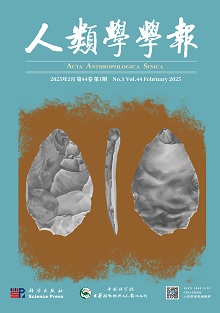Morphological evidence of the formation and diversification of modern Chinese: analysis of cranial non-metric traits in Chinese, African and European populations
LIU Wu; WU Xiu-jie; XING Song; Victoria GIBBON; Ronald CLARKE
2011, 30(03):
250-264.
 Asbtract
(
301 )
Asbtract
(
301 )
 PDF (660KB)
(
401
)
Related Articles |
Metrics
PDF (660KB)
(
401
)
Related Articles |
Metrics
The formation and diversification of modern human populations brought about the emergence of current human populations ( or races ) living in various geographical regions. Physical differences and biological affinities are an important component of studying the formation and diversification of modern human populations. In the present study, the frequency and expression patterns of 21 cranial non-metric traits were analyzed in 330 crania from three main human groups of recent-modern Chinese, modern African and European populations. Our result and some impressions are as follow:
1. Crania of modern Chinese were characterized by gracile morphology with features of robusticity ( e.g., supraorbital structure, angular torus, zygomatic trigone and zygomaxillary tuberosity) much less developed compared to African and European populations. Modern Chinese crania differed from African and European populations in terms of their sharp infero-lateral margin, flat intraglabellar notch, round cranial later profile, flat obelionic and lambdoid region, deeply arc-shaped lower zygomaxillary margin and different frontonasal and frontomaxillary sutures.
2. In terms of non-metric cranial features and population affinities, our results showed different frequency and patterns in most of the features among the three populations with some anatomical traits having significant inter-populational differences. The value of differentiating populations with only one feature is very limited, so in order to explore populational relationships of these non-metric cranial features, discriminant analysis was used to distinguish the three main population groups. Using this approach, between 67 and 79.5 percent of the specimens could be correctly classified (70.4% -82.9% of the Chinese specimens were correctly classified). In the discrimination plots of individual specimens, the African crania were scattered widely, while Chinese and European crania were closely concentrated, suggesting that Chinese and European populations were more derived.
3. Recent studies of non-metric cranial features have begun to analyze the functional or biomechanical morphology of these features, relating them to cranial robusticity, or how robust the crania are in structure. Cranial robusticity is also related to cranial size and thickness, but also expressed by a series of morphological features (referred to as cranial superstructures) including the uplifting ridge, torus and tubercles on the cranial surface. The expression of these robust features is influenced by both genetic and environmental factors and can be very different among populations. Although the evolution of modern Homo sapiens is characterized by skeletal gracilization, a number of robust features still occur in some fossils of early modern humans, as well as recent and modern human skeletons.
This analysis of 21 cranial non-metric features in Chinese, African and European modern human populations indicates that most of the examined features show interpopulation differences related to cranial robusticity, and therefore these types of features must have played a significant role in the formation and diversifications of modern Chinese populations.









